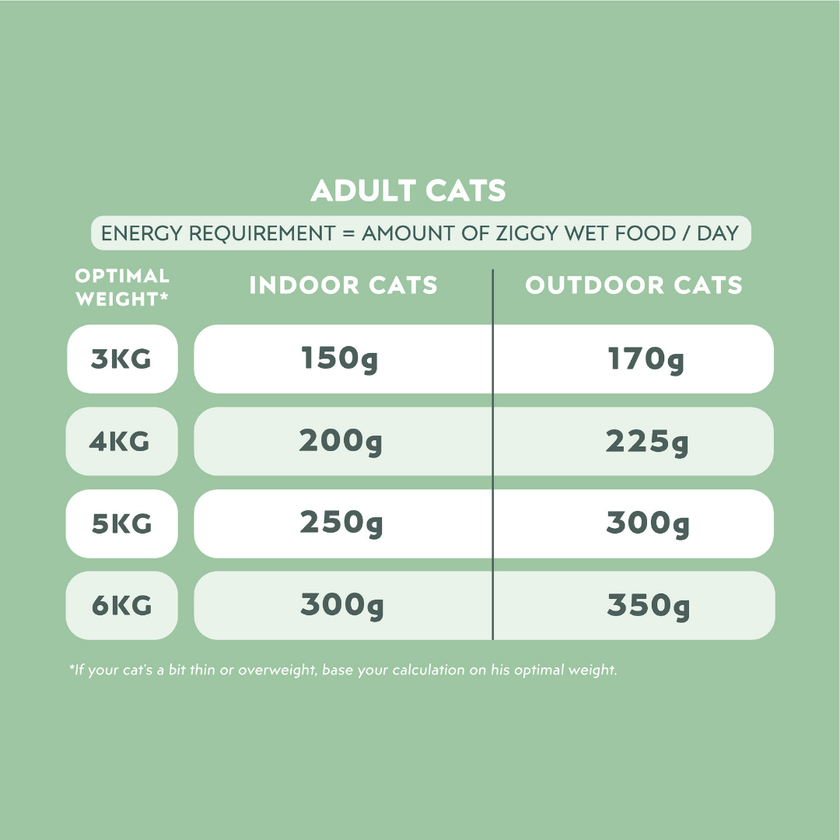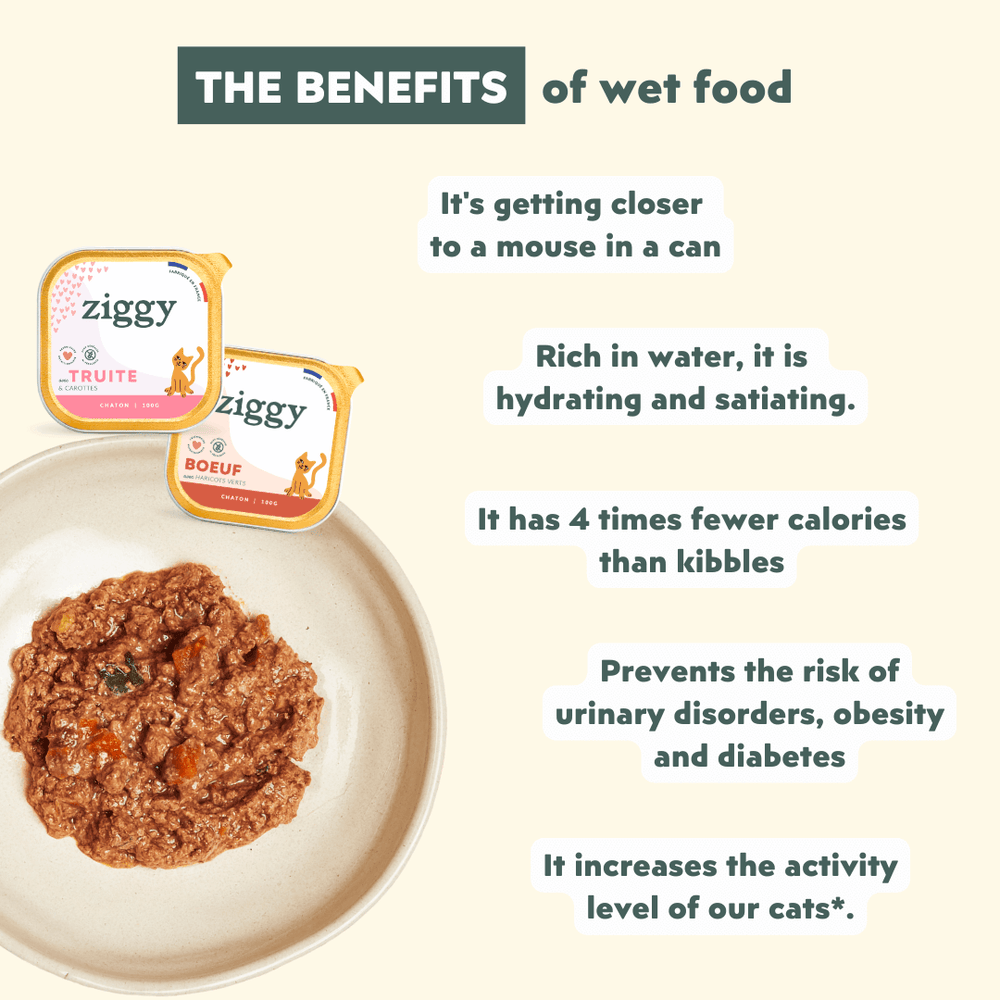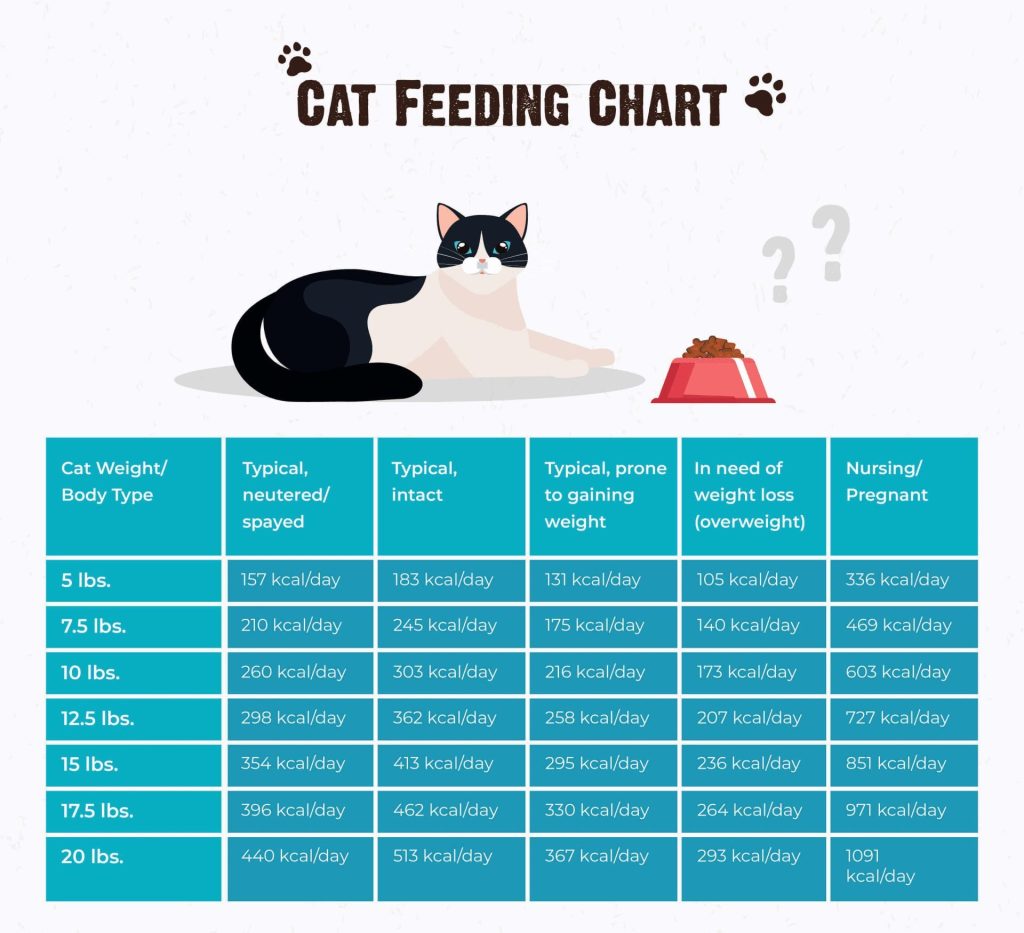Are you wondering how much wet food you should give your cat to keep them healthy and happy? Feeding your cat the right amount of wet food can be tricky.
Too much can lead to weight gain, while too little might leave them hungry and unsatisfied. Finding the perfect balance is key for your cat’s well-being. You’ll discover simple and effective tips to help you feed your furry friend just the right portion every time.
Keep reading to make mealtime stress-free and enjoyable for both you and your cat!

Credit: ziggyfamily.com
Benefits Of Wet Cat Food
Choosing the right food for your cat can make a big difference in their overall well-being. Wet cat food offers unique benefits that dry food often lacks. Understanding these advantages can help you decide how much wet food to include in your cat’s diet.
Hydration And Health
Cats naturally have a low thirst drive, which means they don’t always drink enough water. Wet food contains up to 80% moisture, helping keep your cat hydrated throughout the day.
This extra hydration supports kidney function and can reduce the risk of urinary tract issues. Have you noticed if your cat drinks less when eating dry food? Adding wet food might be the simple fix they need.
Nutritional Value
Wet cat food often contains higher protein levels and fewer carbohydrates compared to dry food. This matches a cat’s natural diet more closely, providing essential amino acids and nutrients.
It’s also easier to digest, especially for older cats or those with dental problems. If your cat struggles with chewing, wet food can ensure they still get the nutrition they need without discomfort.
Palatability And Variety
Cats can be picky eaters, and the texture and aroma of wet food tend to be more appealing. Offering different flavors and textures keeps mealtime interesting and can encourage better eating habits.
Have you tried mixing wet food flavors or adding a bit of warm water to enhance the aroma? Small changes like this might make your cat more excited about their meals.
Factors Affecting Wet Food Quantity
Determining the right amount of wet food for your cat involves more than just following the package instructions. Several important factors influence how much your cat actually needs to stay healthy and happy. Paying attention to these details can help you avoid overfeeding or underfeeding, which can lead to health issues down the road.
Cat’s Age And Weight
Kittens require more calories per pound compared to adult cats because they are growing rapidly. A young cat might need multiple small meals throughout the day, whereas an adult cat usually does well with two meals. Older cats, especially those who have lost muscle mass, might need a different feeding plan tailored to their weight and metabolism.
Weigh your cat regularly to track any changes. If your cat gains or loses weight without changes in food amount, you might need to adjust the portion size. Have you noticed your cat’s weight fluctuating? That’s a clear sign to revisit their food quantity.
Activity Level
Just like people, active cats burn more energy and require more calories. If your cat spends most of the day indoors napping, its caloric needs will be lower. Outdoor or highly playful cats need more fuel to keep up their energy.
Think about your cat’s daily routine. Is your cat chasing toys or lounging all day? Adjusting the wet food quantity based on activity helps prevent weight problems. If your cat suddenly becomes more or less active, be ready to tweak the portions accordingly.
Health Conditions
Some health issues can affect how much food your cat should eat. Cats with kidney disease, diabetes, or digestive problems might require special diets or specific feeding amounts prescribed by your vet. Overfeeding a cat with health problems can worsen their condition.
Always consult your veterinarian if your cat has a medical condition. They can help you determine the right wet food quantity that supports your cat’s health without causing harm. Are you aware of any health changes in your cat that might call for a feeding adjustment?
Daily Wet Food Portions
Daily wet food portions keep your cat healthy and happy. Proper portions support energy and weight balance. Cats need the right amount of moisture and nutrients every day. Wet food is a great way to provide hydration along with calories. Measuring portions helps avoid overfeeding and waste.
Recommended Serving Sizes
Most cats eat between 3 to 5 ounces of wet food daily. This amount depends on the food’s calorie content. Check the label for calorie details per can or pouch. Feeding guidelines usually suggest splitting the daily portion into two meals. Fresh food twice a day keeps cats satisfied and prevents hunger.
Adjusting Portions For Overweight Cats
Overweight cats need smaller portions to lose weight safely. Cut daily wet food by 10 to 20 percent. Choose wet food with fewer calories but high protein. Avoid free-feeding to control calorie intake. Monitor your cat’s weight every week and adjust portions if needed.
Feeding Guidelines By Cat Size
| Cat Size | Daily Wet Food Portion |
|---|---|
| Small (5 lbs) | 2 to 3 ounces |
| Medium (10 lbs) | 4 to 5 ounces |
| Large (15+ lbs) | 6 to 7 ounces |
Portions vary by activity level and age too. Adjust meals for kittens or very active cats. Always provide fresh water alongside wet food.

Credit: ziggyfamily.com
Combining Wet And Dry Food
Combining wet and dry food can offer your cat a balanced diet with variety. Wet food provides moisture and rich nutrients, while dry food supports dental health and is easy to store. Mixing both types keeps your cat interested in meals and covers different dietary needs.
Balancing Nutrients
Wet food usually contains more protein and fewer carbs than dry food. Dry food often has added vitamins and minerals to support overall health. Combining them ensures your cat gets a wide range of nutrients. Make sure to check labels and avoid overfeeding calories.
Meal Frequency And Timing
Feed wet food in smaller portions two to three times daily. Dry food can be left out for grazing or given in measured amounts once or twice a day. Consistent meal times help regulate your cat’s digestion and prevent overeating. Watch how your cat responds to different feeding schedules.
Monitoring Intake
Track how much wet and dry food your cat eats each day. Use a measuring cup or scale for accuracy. Adjust portions based on your cat’s weight, activity, and health. Look for signs like weight gain, loss, or changes in energy. Proper monitoring keeps your cat fit and happy.
Signs Of Overfeeding And Underfeeding
Recognizing the signs of overfeeding and underfeeding your cat is crucial to maintaining their health and happiness. It’s easy to assume more food means better care, but too much or too little wet food can lead to serious issues. Watching for clear signals can help you adjust feeding amounts before problems arise.
Weight Changes
One of the most obvious signs is a change in your cat’s weight. If your cat is gaining weight quickly, it might be a sign of overfeeding. Conversely, if your cat looks thinner or is losing weight, underfeeding could be the cause.
Keep a regular check on your cat’s body condition. You should be able to feel their ribs without pressing too hard, and they should have a visible waist when viewed from above. Sudden or drastic weight changes are a red flag to revisit feeding amounts.
Behavioral Indicators
Your cat’s behavior can tell you a lot about whether they’re eating the right amount. Overfed cats may become lethargic or less interested in playing, while underfed cats might seem restless or constantly hungry.
Pay attention to begging behavior or signs of discomfort after meals. If your cat is frequently meowing for food shortly after eating, it could mean they aren’t getting enough. On the other hand, a cat that refuses food or leaves a lot uneaten might be getting too much or feeling unwell.
Health Risks
Overfeeding increases the risk of obesity, which can lead to diabetes, joint problems, and heart disease in cats. Underfeeding, however, can cause malnutrition, weakened immune function, and muscle loss.
Both extremes affect your cat’s quality of life and longevity. If you notice any health issues or unusual symptoms, consult your vet about your cat’s diet and feeding schedule to avoid long-term complications.

Credit: www.walmart.ca
Tips For Feeding Wet Food
Feeding wet food to your cat can improve their hydration and provide balanced nutrition. Proper feeding helps keep your cat healthy and happy. Here are some useful tips to make feeding wet food easier and more effective.
Storage And Serving
Store unopened wet food cans in a cool, dry place. Once opened, refrigerate leftovers in a sealed container. Serve wet food at room temperature for better taste. Cold food can be less appealing to cats. Use clean bowls to prevent bacteria growth. Avoid leaving wet food out for more than two hours. This keeps your cat safe from spoilage.
Encouraging Picky Eaters
Try warming the food slightly to enhance smell and flavor. Mix a small amount of wet food with dry food. Offer different flavors or brands to find your cat’s favorite. Hand feeding can build trust and interest. Use positive reinforcement like gentle petting during meals. Be patient; some cats take time to adjust.
Maintaining Freshness
Cover opened cans with plastic wrap or use airtight lids. Use leftovers within 24-48 hours for best quality. Clean feeding bowls daily to avoid odors and bacteria. Avoid mixing fresh food with old leftovers. Fresh food encourages your cat to eat regularly and enjoy mealtime.
Frequently Asked Questions
How Much Wet Food Should I Feed My Cat Daily?
Feed your cat about 3 to 5. 5 ounces of wet food daily. This depends on their weight, age, and activity level.
Can I Mix Wet Food With Dry Food For Cats?
Yes, mixing wet and dry food can provide balanced nutrition. It helps maintain hydration and dental health.
How To Adjust Wet Food Portions For Overweight Cats?
Reduce wet food portions gradually while monitoring weight. Consult your vet for a tailored feeding plan to ensure health.
Is It Safe To Free-feed Wet Cat Food?
Free-feeding wet food is not recommended. It can spoil quickly and cause overeating. Serve measured portions instead.
Conclusion
Finding the right amount of wet food is crucial for your cat’s health. Every cat is unique, with its own dietary needs. Start with guidelines on the food label. Then, watch your cat’s weight and energy. Adjust as needed. Consult your vet for personalized advice.
Keep your cat’s water intake in mind too. Wet food helps with hydration. Balance wet food with dry kibble for variety. A happy, healthy cat will thank you with purrs and cuddles. Remember, a balanced diet leads to a longer, happier life for your feline friend.

